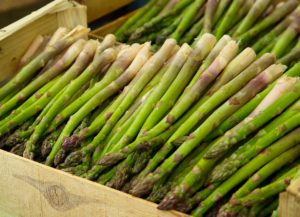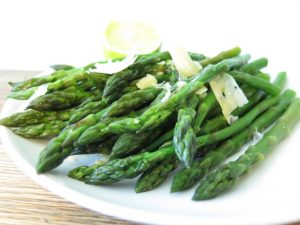 Spring is asparagus season, from April to June. While we may enjoy asparagus all year long, it is most delicious and nutritious when in season. Native to the Eastern Mediterranean region, asparagus has been cultivated for at least 2,000 years. It is one of the few vegetables that is a perennial, which means that it does not need to be planted each year—the plants live around 15 years or more.
Spring is asparagus season, from April to June. While we may enjoy asparagus all year long, it is most delicious and nutritious when in season. Native to the Eastern Mediterranean region, asparagus has been cultivated for at least 2,000 years. It is one of the few vegetables that is a perennial, which means that it does not need to be planted each year—the plants live around 15 years or more.
Nutrition
- Asparagus is not only delicious, but also very nutrient-dense. Nutrient density refers to the amount of vitamins, minerals, and fiber as compared to the amount of calories. A cup of asparagus has only about 40 calories and is an excellent source of many essential nutrients such as Vitamin K, folate, vitamin A, vitamin C, and thiamin.
- Asparagus contains a specific fiber called inulin, which has prebiotic properties helping to feed gut microbes, and has been studied for its beneficial impact on the gut microbiome.
- Like most vegetables, asparagus is a great source of phytonutrients, which have a range of benefits. For example:
- Asparagus contains quercetin, which is linked to reduced cardiovascular disease.
- It also contains saponins, which may positively impact cardiovascular health, immune function, and cancer risk.
- Glutathione is another phytochemical present in asparagus which is known as the body’s “master antioxidant” and is vital for the immune system and protecting cells from oxidative damage.
 Selection, Storage and Preparation
Selection, Storage and Preparation
- Asparagus cannot be stored as long as some vegetables; it is best to eat it as soon as possible after purchase, with 2-5 days.
- Shop for firm, smooth, straight, and bright green plants (or white or purple if you can find them), with compact tips.
- Store wrapped in plastic in the fridge. For best results, you can also place them upright in a jar with a little water, or wrap the bottom ends in a damp paper towel.
- Cut off the bottom inch, and then use a peeler to peel the rest of the bottom half. This can lead to less waste than cutting or breaking off a large portion of the bottom.
- Roast, grill, boil, steam, microwave, pickle, or even eat raw. Serve with ingredients such as lemon, olive oil, butter, egg, Hollandaise sauce or Parmesan cheese.
Try out one of these ideas for preparing asparagus, or explore your own!
- Toss asparagus in olive oil, lightly sprinkle with salt and pepper, roast in the oven, and top with finely shredded Parmesan cheese

Asparagus is delicious grilled! - Chop tender spears of asparagus into small pieces and add to a salad with a vinaigrette dressing
- Sauté with onion, simmer in broth, then puree for a simple creamy soup
- Chop finely, sauté, and add to scrambled eggs or an omelet
- Add to a stir fry with a variety of spring veggies, soy sauce, and garlic
- Rinse and trim spears and place in a microwave-safe bowl with a lid; add ¼ cup water and cook on high for about 3-7 minutes; toss with butter and lemon juice

